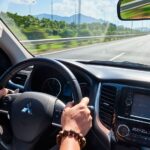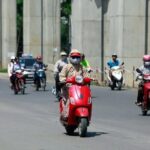1. Maintain Proper Tire Pressure
Keeping your tires inflated to the manufacturer’s recommended pressure will help your vehicle optimize traction during operation and reduce fuel consumption. This is because when tires are at the correct pressure, they ensure the optimal tire contact patch with the road to maintain stable frictional force. This not only makes the car more fuel-efficient but also safer to drive.

Maintain tire pressure according to the manufacturer’s specifications to optimize fuel efficiency.
According to experienced drivers, when traveling long distances, tires will heat up due to friction with the road. Therefore, when inflating your tires, it is advisable to keep the pressure slightly lower, around 10-15% below the recommended level. After a short while, the air inside the tires will heat up and expand, bringing the pressure to the desired level. For example, if the recommended pressure is 2.3 bar, inflate the tires to approximately 2.15-2.2 bar, leaving room for air expansion as it heats up.
Ideally, drivers can fill their tires with nitrogen to stabilize temperature and pressure even when driving continuously in hot weather. Nitrogen is less prone to expansion and leakage compared to regular air.
2. Regular Vehicle Maintenance and Care
To ensure fuel efficiency, a car needs to be maintained and cared for regularly, adhering to the manufacturer’s recommendations. Before each trip, it is essential to inspect and service the vehicle, including oil changes, cleaning the brake pads, and wheel alignment, to guarantee optimal performance.

Vehicles require maintenance and care before and after each journey.
For extended trips or journeys on rough roads, it is advisable to have your car inspected after the trip to address any issues that may have arisen during the journey.
3. Avoid Unnecessary Cargo
Optimizing the weight of your vehicle for long-distance travel is crucial. The lighter the vehicle, the less fuel it consumes. Therefore, before embarking on your trip, create a list of essential items and leave behind any unnecessary belongings. This will not only reduce weight but also provide more comfort and space for passengers.

Reducing the vehicle’s weight will lead to improved fuel efficiency.
4. Smooth Acceleration and Avoid Hard Braking
Whether driving in urban areas or on highways, it is essential to smoothly modulate the accelerator. Avoid sudden acceleration, as it increases fuel consumption due to the sudden increase in power and traction required by the vehicle.

Drivers should actively observe and anticipate traffic situations to smoothly control acceleration and braking.
Additionally, when decelerating, anticipate the traffic situation and gently apply the brakes to allow the vehicle to slow down gradually. This not only optimizes kinetic energy and fuel efficiency but also provides a more comfortable ride for passengers.
5. Maintain Engine RPM between 1,500 and 1,750
For most modern vehicles equipped with CVT or 5-6 speed automatic transmissions, the optimal engine RPM for fuel efficiency lies between 1,500 and 1,750. When driving on highways, you can refer to your vehicle’s transmission characteristics to select the appropriate gear, optimizing performance and minimizing fuel consumption.

Paying attention to gear selection and engine RPM will help drivers improve fuel efficiency.
Operating the vehicle within this optimal RPM range will result in a smoother engine, reduced engine noise in the cabin, and an overall more comfortable driving experience for all occupants.
According to VTC
“Tips for Driving During the Summer Rush Hour”
The summer weather in Vietnam can be unforgiving with scorching heat and high temperatures taking a toll on both drivers and their vehicles. With the mercury rising, it becomes even more crucial to pay extra attention to car care and maintenance to ensure a safe and comfortable driving experience during this challenging season.
Does Hot Weather Require Releasing Air from Motorcycle Tires?
As the sun beats down and temperatures rise, your car tires are quietly enduring a similar fate. The scorching heat causes the air inside the tires to expand, resulting in a subtle yet significant increase in tire pressure. This natural phenomenon is a subtle reminder of the intricate relationship between weather and the performance of your vehicle.



































